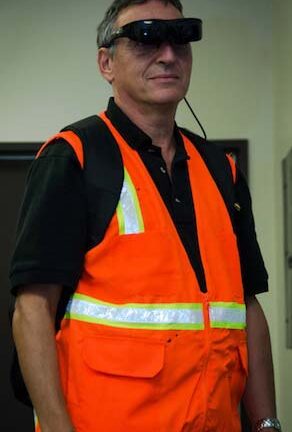
Gerard Medioni, above, and James Weiland have created a pair of glasses and a vest that help the blind make their way around obstacles in their path.
New technology that can help the blind
From the moment we open our eyes in the morning, our brain processes, seemingly effortlessly, what we see. Eugenia Barrera does not have this luxury. For her and the estimated 6.5 million blind or visually impaired Americans, life is more complicated.
Even in her own home, Barrera struggles to navigate and find specific items. Stepping into an unfamiliar environment can elevate these difficulties from somewhat challenging to incredibly stressful.
Gerard Medioni, professor of computer science at the USC Viterbi School of Engineering, wants to make it easier for Barrera and other visually impaired people to get around. He and biomedical engineering Professor James Weiland, along with their teams, have created a pair of glasses and a vest that do just that.
This glasses-vest combination is a type of “seeing eye” for the blind. The glasses observe the environment and the vest gives directions, much like a seeing-eye dog sees and leads.
Using two cameras, the glasses create a 3-D image of the surrounding environment. Though the blind person cannot see this image, the computer can, using it to analyze the setting.
With this image, the computer can distinguish between obstacles and open space. Using this information, the computer sends signals to a vest through four sensors, much like the brain sends messages to the body.
Getting close to an object triggers a warning buzz. If a person is too close to a table on their left, the lower left sensor would buzz, telling the person to move away from that object. No sound means all clear.
The research started out in 2008 with the simple task of autonomously navigating an obstacle course, originally funded by a grant from the National Science Foundation. The project is currently funded by the Telemedicine and Advanced Technology Research Center. Through collaboration with the Braille Institute, Barrera tested this technology in a parking lot. It gave her a sense of independence she had not previously experienced.
“For me, it was very freeing,” she said. “It gave me freedom to not have to ask so many people for help. I can be more independent.”
The project was largely successful, but Medioni and his team did not stop there. He realized that life is not a static obstacle course made in a laboratory.
In real-life scenarios, obstacles are not always stationary. Often, they are moving people. Still, people will move out of the way. So Medioni and his team advanced their technology to differentiate between threatening obstacles/buildings, branches or benches and nonthreatening obstacles, such as people.
To test this technology, the team imagined the most hectic scene possible: the USC campus on a football game day, when swarms of people can overwhelm even someone with 20/20 vision. The glasses and vest successfully led a team member to a destination without the vest buzzing incessantly.
The next real-life obstacle course the team will test this month is a grocery store. The glasses-vest combination will lead the test subject to a specific item in the grocery store for them to pick up.
Medioni enjoys his research and how it helps people in need.
“The best part of it all is that people actually like the system,” Medioni said. “We really started from the beginning to involve patients and get their feedback and make sure that this was something that would be helpful and useful.”
Based on this feedback, Medioni and his team added one more layer of complexity to the problem: communication. They recognized that lack of vision makes it difficult, if not impossible, to understand nonverbal communication, such as hand gestures or facial expressions. Medioni wants to change that by addressing the most complex and nuanced issue yet.
This would allow a blind person to fully understand the situation, such as a meeting taking place at work. With facial recognition technology, the blind people would be able to tell who is being addressed based on where someone is looking or how serious or lighthearted the speaker is based on facial expressions.
Medioni is experimenting with ways to communicate this information to the blind person, potentially using the vest again or deploying a speaker in their ear.
“They want to be part of the working environment,” Medioni said. “They want to be inserted in society and that’s really what we are trying to help them accomplish.”
The project is still in its early stages.
Barrera, for one, has become a big fan of Medioni’s work and its implications for people like her.
“I keep telling them to hurry up and finish,” Barrera said. “I need this in my life.”



